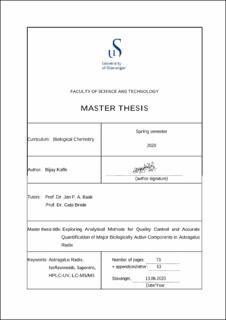| dc.description.abstract | Abstract
Introduction
Over the past decade, the worldwide consumption and sales of Traditional Chinese Medicine (TCM) herbs have grown enormously. Astragalus Radix (Chinese: Huang qi) (AR), the dried root of Astragalus membranaceous is a typical example. It is widely used in TCM to boost the body’s immune system, to reinforce the vital energy (“Qi” in Chinese) and for the treatment of bronchitis, pneumonia, and fatigue. The bioactive compounds of AR are flavonoids, saponins, polysaccharides, amino acids, and trace elements.
In many countries (China, Japan, the USA, and Europe), Pharmacopeia’s and monographs have been published, which describes the morphological characteristics and procedure for assays to test the quality and standardization of medicinal plants. The purpose of the study is to routinely investigate the quality of herbs, analysing the bioactive compounds in a highly accurate, reproducible, qualitative, and quantitative manner.
Objectives
1. Identification and quantification of isoflavonoids (formononetin, ononin, and calycosin-7-O-β-D glucoside) and saponins (astragaloside IV and cycloastragenol) in Astragalus Radix samples.
2. Technical comparison and use of improved methods for the quantitative determination of chemical components in AR samples and,
3. Comparison of commercial samples from different vendors.
Methods
Chemical standards were used for comparison and confirmation. Ultrasonication extraction was performed for a higher yield and sample preparation was optimized. Thin-layer chromatography (TLC) was used for detecting the presence of compounds. These were confirmed afterward when TLC plates were used in mass spectrometric (MS) detection. Fourier Transform Infrared Spectroscopy (FTIR) analysis was used to identify the functional groups of bioactive chemical compounds. The samples were further analysed using rapid and sensitive high-performance liquid chromatography–ultraviolet detector (HPLC-UV) and tandem mass spectrometric (LC-MS/MS) methods. The chromatographic conditions were optimized using the gradient elution of 0.2% formic acid in water and acetonitrile as mobile phases for HPLC-UV and methanol instead of acetonitrile in LC-MS/MS. The isoflavonoids were measured with a detection wavelength of 254 nm using a diode-array detector. The triple quadrupole tandem mass spectrometer was operated using positive electron-ionization modes and monitored using multiple reaction monitoring (MRM). The method was validated for linearity, selectivity, accuracy, and precision. External calibration and standard addition were performed during LC-MS/MS analysis.
Results
TLC-MS analysis of Astragalus Radix samples showed four of the five compounds detected. Compared with the other bioactive compounds, cycloastragenol gave very low-intensity peaks. The FTIR spectra of the sample extracts were not good enough to make a baseline fingerprint, but some functional groups could still be detected. The three isoflavonoids could successfully be quantified by HPLC-UV in different extracts of AR samples, but not formononetin in hydrophilic concentration. The presence of the latter was confirmed by LC-MS/MS. Astragaloside IV and cycloastragenol could not be detected by the UV method, while all five standards of compounds were detected using tandem mass spectrometry. LC-MS/MS method is a more selective, sensitive, reliable, and accurate method than HPLC-UV for the analysis of bioactive compounds of AR. Compared to external calibrations in LC-MS/MS, the quantitative results were significantly improved by using standard addition performed by adding known concentrations of standards to the sample solutions. These improved results can be due to a reduction in matrix effects by dilutions and ion suppression. Cycloastragenol was not detectable in any of the Astragalus Radix samples. The concentration in sample extracts might be below the detection limit or be naturally absent. The peaks in both MRM channels in exact retention times were not seen. Samples from different vendors contain widely different concentrations of the bioactive compounds, indicating much lower quality of Astragalus Radix samples from certain vendors. The highest concentration of astragaloside IV (203 ± 6 µg/g) was present in granulate samples from one vendor, whereas capsules from another vendor contained more ononin and calycosin 7-O-β-D glucoside. Formononetin in the capsule sample was comparable with samples from different vendors. The lowest concentrations of all compounds were observed in tablets from one vendor. This is partly but not completely understandable, as the tablets contain raw herbs rather than granulates (granulates are on average 3-5 times more concentrated than raw powder).
Conclusions
In the absence of isotopic labelled internal standards, the accuracy of quantification of bioactive components in Astragalus Radix samples of LC-MS/MS can be improved by using standard addition. The standard addition method was applied in diluted samples and quantification was independent of variations in signal response caused by matrix effects. LC-MS/MS was found to be significantly more sensitive and accurate than HPLC-UV for the measurement of essential bioactive compounds of AR. LC-MS/MS therefore should be used for Quality control of AR samples. This is probably also true for many other traditional Chinese medicine herbs, in the absence of isotope labelled internal standards. However, this should be further investigated. Another incredibly important research project would be to assess the pharmacokinetics of AR compounds in different persons, under various conditions, in blood, tissues, cells, and excretions (feces, urine, saliva). The results will assist the personalized dosing of AR herb in individual patients with different diseases.
Keywords: Astragalus Radix, Isoflavonoids, Saponins, HPLC-UV, LC-MS/MS | en_US |
